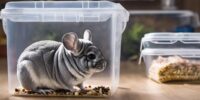How to Incorporate Natural Elements Into Ferret Habitats
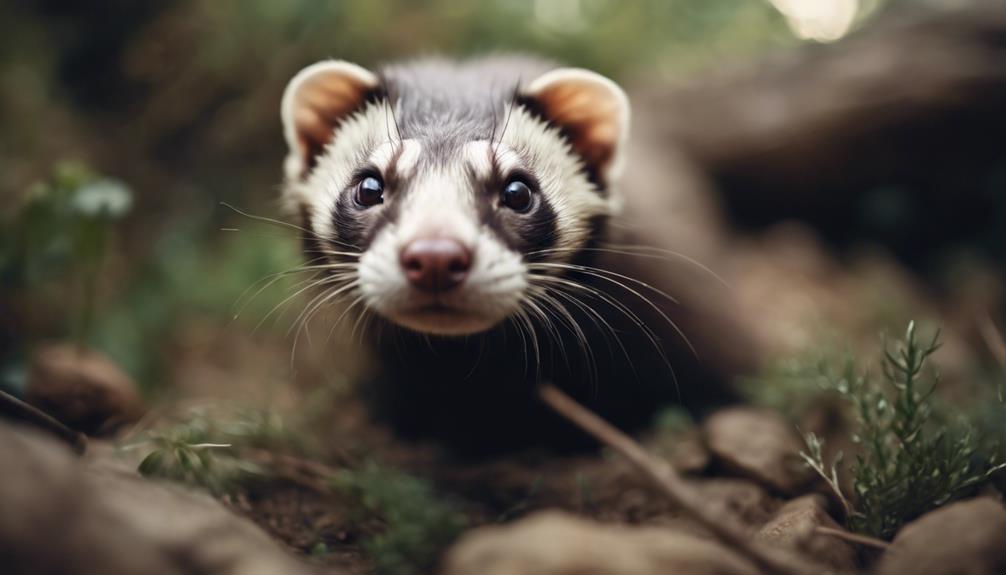
Creating a natural habitat for your ferret involves providing a mix of different elements that mimic their natural environment. Start by setting up a spacious cage with plenty of room for your ferret to move around and explore. Include hiding spots like tunnels and hammocks, as well as soft bedding for them to rest in.
Ferrets also need mental stimulation, so provide toys and activities to keep them entertained. Incorporate items like tunnels, balls, and puzzle feeders to encourage play and exploration. Additionally, make sure to include a litter box and fresh water at all times.
To create a more natural feel, add branches and logs for climbing and chewing, as well as safe plants for your ferret to interact with. Avoid toxic plants and ensure that all items are securely attached to prevent accidents. Regularly clean and maintain the habitat to keep your ferret healthy and happy.
Remember to monitor your ferret's behavior and adjust their habitat as needed to ensure they have a comfortable and enriching environment.
Choose Suitable Natural Materials
When creating a habitat for ferrets, it's essential to carefully select natural materials that mimic their natural environment. Forest-inspired decor and a natural toy selection can provide mental stimulation and enrichment for these curious creatures. Ensuring an eco-friendly design with sustainable materials not only benefits the environment but also contributes to the overall well-being of the ferrets.
Incorporating forest-inspired decor can include items like logs, branches, and leaves to create a setting reminiscent of a woodland habitat. These elements offer opportunities for climbing, exploring, and hiding, which are essential activities for ferrets. Natural toy selection should involve items like wooden chew toys, tunnels made of natural fibers, and balls made from sustainable materials to encourage play and exercise.
Provide Hiding Spots for Exploration
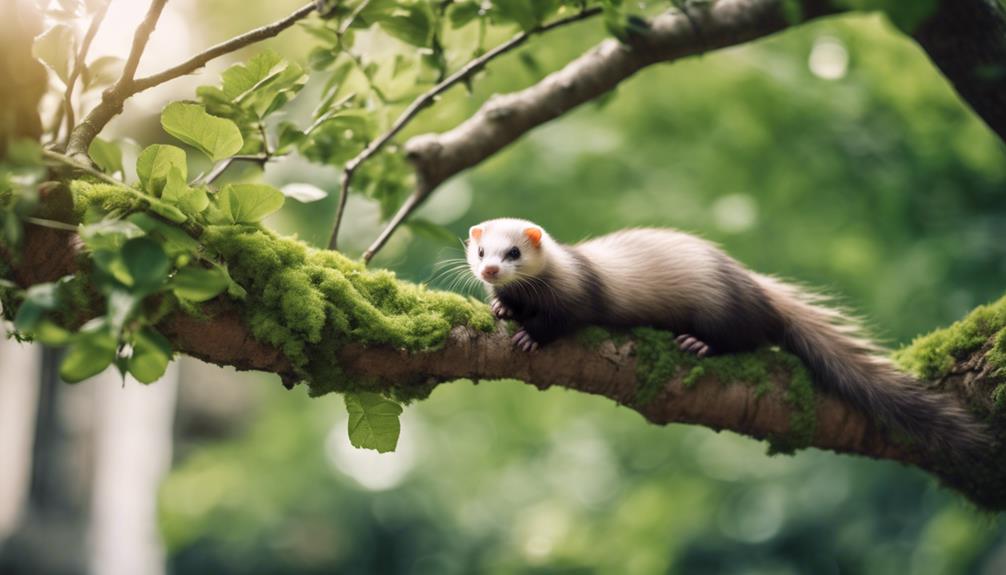
To enhance the exploration experience for ferrets in their habitat, it's crucial to provide various hiding spots that cater to their natural instincts and behaviors. Ferrets are curious creatures that enjoy exploring and seeking shelter in concealed areas. Here are some key elements to consider when creating hiding spots for ferrets:
- Camouflage Tunnels: Ferrets love to burrow and hide in tunnels. Providing camouflage tunnels made from natural materials like straw or branches allows them to exhibit their natural digging behaviors while feeling secure in their hiding spot.
- Tree Branch Perches: Incorporating tree branch perches at different heights in the habitat gives ferrets the opportunity to climb and explore vertically. Ferrets are agile climbers and enjoy perching on elevated spots to observe their surroundings and rest comfortably.
- Natural Hideaways: Introducing natural hideaways such as wooden boxes, overturned pots, or hollow logs provides ferrets with secluded spots to retreat to for privacy and relaxation. These hideaways mimic the cozy dens ferrets would seek in the wild, ensuring they feel safe and at ease in their habitat.
Incorporate Climbing Opportunities
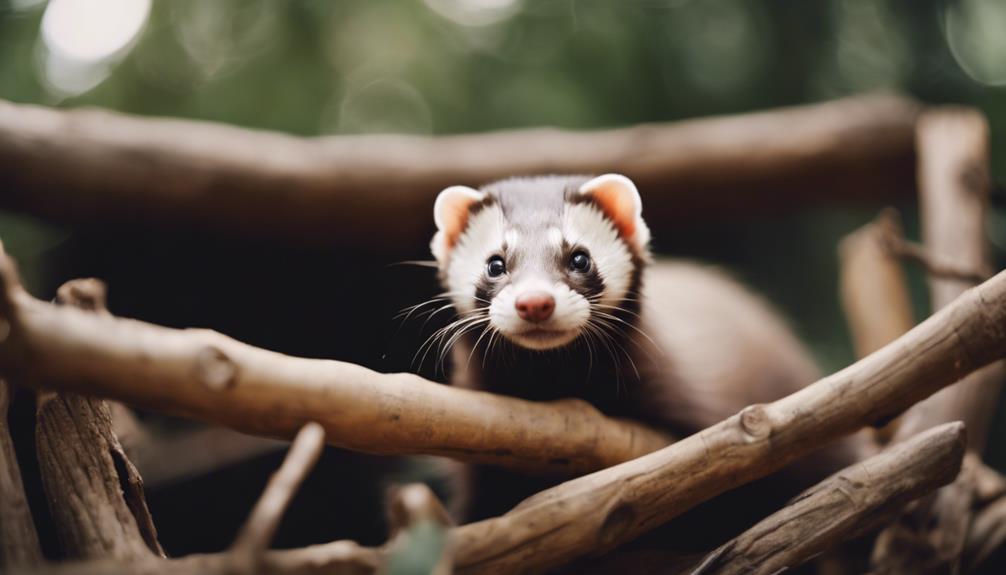
Within ferret habitats, integrating vertical structures such as wooden ladders and ropes enables these agile creatures to engage in their natural climbing behaviors, promoting physical activity and mental stimulation. Climbing opportunities not only mimic their wild instincts but also provide exercise and entertainment. Adding rope bridges and tunnels can offer exciting pathways for ferrets to explore, encouraging their curiosity and dexterity. Tree branch perches create elevated spots for rest and observation, mimicking their natural arboreal environments. Hammocks provide cozy spots for relaxation, allowing ferrets to lounge comfortably off the ground.
| Climbing Structures | Benefits |
|---|---|
| Wooden ladders | Facilitate climbing exercise |
| Rope bridges, tunnels | Stimulate curiosity and exploration |
| Tree branch perches | Offer elevated resting and observation |
| Hammocks | Provide comfortable lounging spots |
Create a Foraging-Friendly Environment
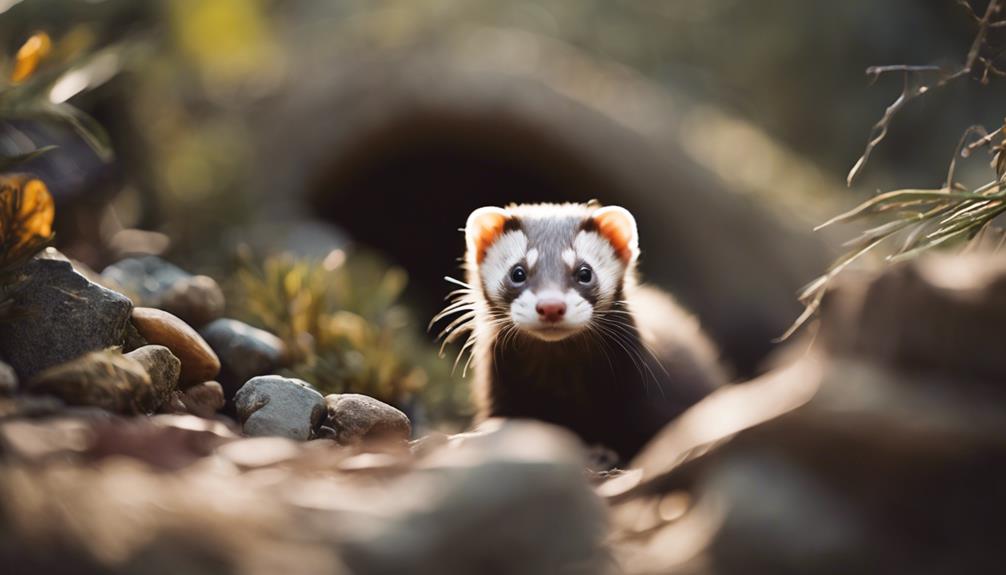
Integrating foraging opportunities into ferret habitats enhances their natural instincts and promotes mental stimulation. Ferrets are natural hunters and thrive when given the chance to engage in activities that mimic their instinctual behaviors. Creating a foraging-friendly environment can be beneficial for their overall well-being.
- Foraging Games: Incorporating interactive foraging games like puzzle feeders or hidden treat boxes can encourage ferrets to use their problem-solving skills while seeking out their food. These games engage their senses and provide mental stimulation.
- Enrichment Toys: Introducing enrichment toys such as balls with treats inside or toys that dispense food when manipulated can keep ferrets entertained and mentally engaged. These toys tap into their natural curiosity and help prevent boredom.
- Hide and Seek: Setting up hiding spots or tunnels where treats can be hidden allows ferrets to indulge in their natural scavenging instincts. This activity not only provides mental enrichment but also encourages physical activity as they explore their environment.
Introduce Safe and Edible Plants
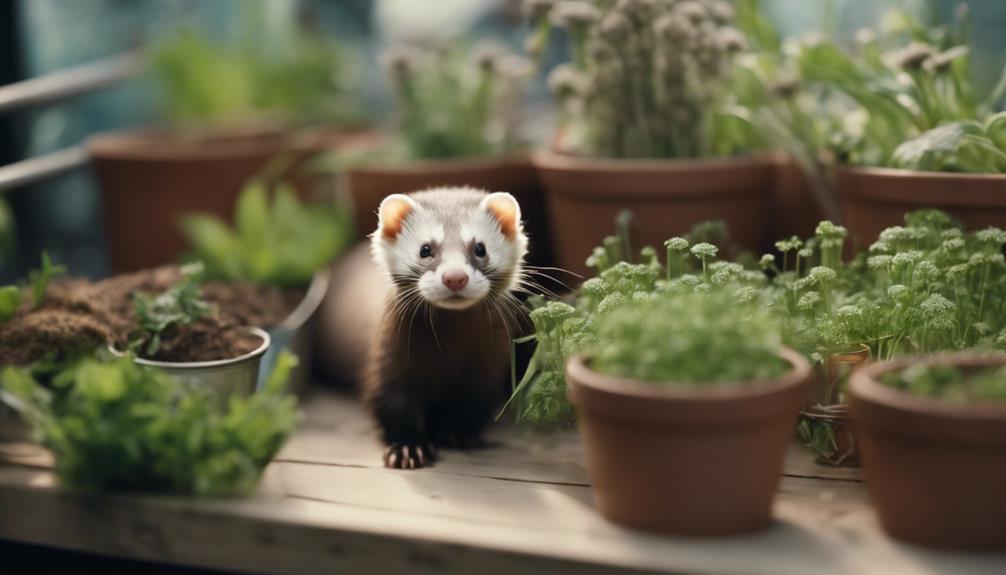
Incorporating safe and edible plants into ferret habitats provides a natural and enriching environment for these curious creatures. When choosing plants, it's crucial to consider both the ferret diet and the safety of the foliage. Opt for plants that are non-toxic and suitable for consumption by ferrets, such as catnip, dill, and parsley. These plants not only add variety to the ferret's diet but also offer mental stimulation and enrichment through foraging activities.
To ensure the plants remain safe for the ferrets, it's advisable to place them in enclosed spaces within the habitat. This prevents the ferrets from overeating or damaging the plants beyond repair. Enclosed spaces also create designated foraging areas, promoting natural behaviors and preventing accidental ingestion of harmful substances.
Offer Natural Bedding Options
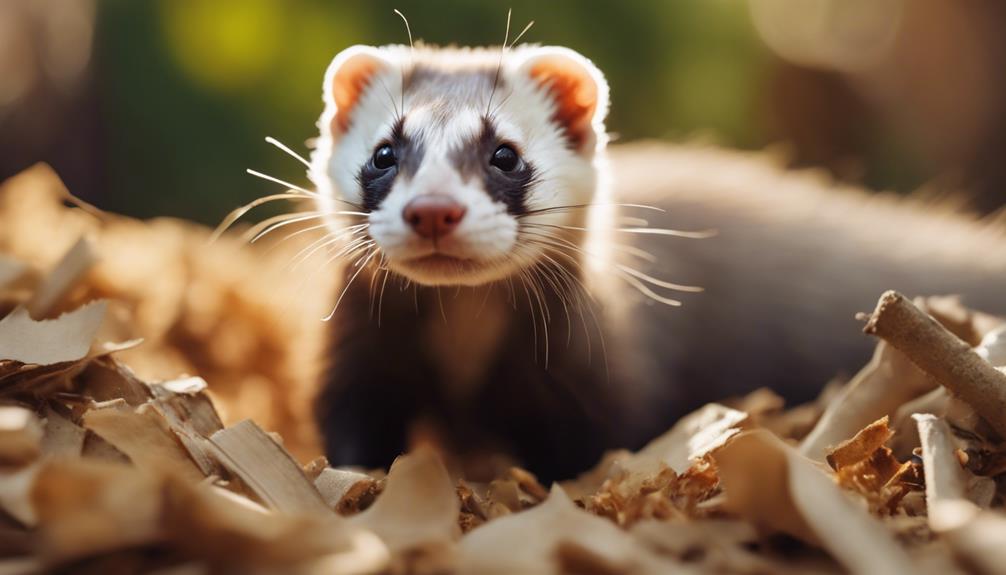
Natural bedding options present an opportunity to enhance ferret habitats with materials that cater to their instinctual nesting behaviors and provide comfort in their living environment. Ferrets, being burrowing animals, benefit greatly from having a cozy and natural bedding setup in their habitat.
Some sustainable sources and eco-friendly options for ferret bedding include:
- Organic Paper Bedding: Made from recycled paper materials, this bedding option is safe, absorbent, and comfortable for ferrets to burrow in.
- Natural Fleece: Fleece made from sustainable sources provides a soft and warm bedding alternative that can be easily washed and reused.
- DIY Digging Boxes: Creating a digging box filled with natural materials like soil, sand, or shredded leaves allows ferrets to exhibit their natural digging behaviors.
Implement Regular Habitat Maintenance
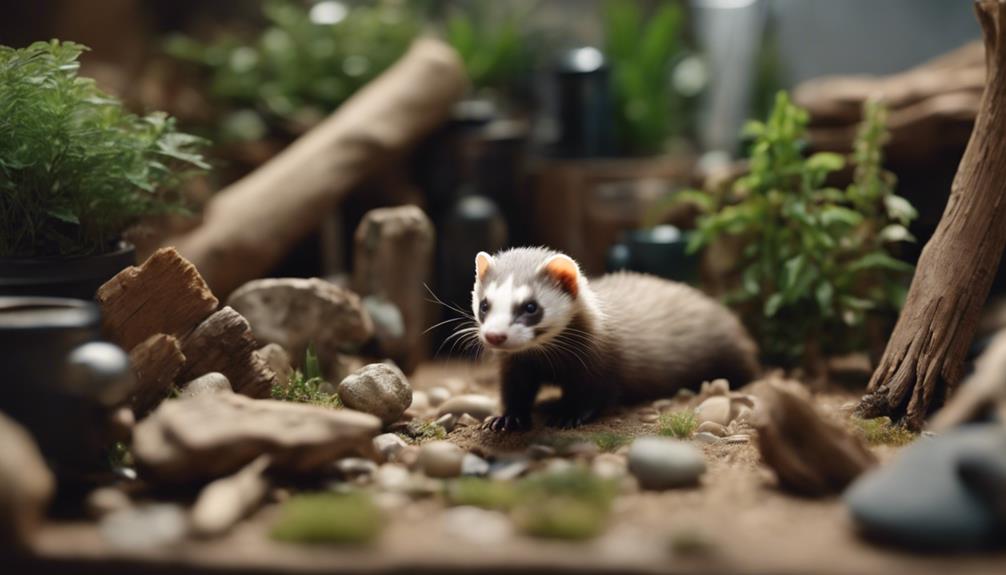
To maintain optimal living conditions for ferrets and ensure their well-being, a consistent schedule of habitat maintenance is essential. Regular cleaning routines play a crucial role in keeping the natural elements within the habitat enriched and safe for your ferrets. It's recommended to spot clean the habitat daily, removing any waste or uneaten food. Additionally, a thorough cleaning should be performed weekly, including washing and replacing bedding, scrubbing surfaces with pet-safe cleaners, and ensuring proper ventilation.
Maintenance tips for ferret habitats also involve checking and replacing any worn-out or damaged natural elements, such as wooden toys or branches, to prevent potential hazards. Regularly inspecting the habitat for any signs of wear and tear is important for the overall safety of your ferrets. By maintaining a clean and enriched environment, you not only provide a healthy space for your ferrets to thrive but also create a stimulating and engaging habitat that promotes their well-being.
Frequently Asked Questions
Can Ferrets Safely Interact With Live Plants in Their Habitat?
To explore the safety of ferrets interacting with live plants, one must consider the potential risks and benefits. Understanding ferret behavior in relation to plant interaction is crucial for creating a natural habitat that prioritizes pet safety.
How Often Should Natural Bedding Options Be Replaced or Refreshed for Ferrets?
Ferret bedding maintenance is crucial for habitat enrichment. It's recommended to refresh natural bedding every 1-2 weeks to promote hygiene and prevent odors. Observing ferret behavior during playtime can also indicate when bedding needs replacing.
Are There Any Specific Types of Climbing Opportunities That Ferrets Prefer?
Ferrets have natural climbing preferences due to their inquisitive nature. Observing their behavior can help in creating DIY climbing structures that serve as enrichment activities. Providing varied climbing opportunities can keep ferrets engaged and active.
What Are Some Common Mistakes to Avoid When Incorporating Natural Elements Into a Ferret Habitat?
Common pitfalls to avoid when incorporating natural elements into a ferret habitat include using toxic plants, sharp materials, or inadequate climbing structures. Safety precautions, like secure installations and monitoring, ensure an ideal environment for ferrets.
How Can I Ensure That the Safe and Edible Plants Introduced to the Habitat Are Not Harmful to My Ferret?
To ensure safe and edible plants for ferrets, research plant toxicity. Incorporate natural enrichment by planting non-toxic herbs like basil or parsley. Monitor Ferret foraging to prevent harmful ingestion. Consider Ferret diet needs for a balanced habitat.





